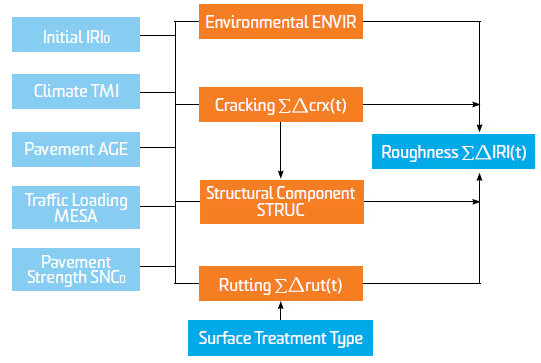

The long-term pavement performance (LTPP) observational study conducted from 1994 to 2018, in conjunction with the accelerated loading facility (ALF) experimental data, has developed robust deterministic mechanistic-empirical road deterioration models for the gradual deterioration phase for flexible pavement arterial roads in Australia.
The RD models for rutting and roughness have statistically significant explanatory variables that cover potential changes in traffic load, climate and surface maintenance treatments. These models, along with the cracking and structural deterioration models are being adapted, by means of local calibration and adjustments, to PMSs operated by state road agencies for their arterial road networks. The local calibration can account for local conditions of pavement drainage and soil moisture as well as the reactive nature of some soils.
A recent upgrade of the rutting and roughness RD models, using relative performance factors for surface maintenance treatments, accounts for the discrete impact of different surface maintenance treatments on the rate of deterioration. This has improved the utility of the RD models that no longer rely on an estimate of the average annual surface maintenance expenditure ($/lane-km) variable, me, based on the year 2000 costs.
As noted, the RD models will be further refined by 2022 with additional LTPP observational data from Australia and New Zealand.
The prediction of pavement performance is critical when using a pavement management system (PMS) for estimating maintenance and capital funding requirements for road networks. In the past many of the performance prediction models, such as the World Bank’s HDM models, used in PMSs in Australia were based on data collected in Brazil, the Caribbean and Kenya from 1971 to 1984 (Cox 1990). Most of these models were not suited to Australian conditions of construction, maintenance, climate and traffic as sprayed bitumen sealing over an unbound crushed rock base occurs mainly in Australia, New Zealand and South Africa.
The United States (US) long-term pavement performance (LTPP) program started in 1987 as part of the Strategic Highway Research Program (SHRP), a five-year applied research program funded by 50 US states and managed by the Transport Research Board (Crawley 1997). After the SHRP ended in 1992 as planned, the LTPP program continued under the leadership of the Federal Highway Administration (FHWA) until the present time and is expected to remain active for many more years to come.
ARRB was directly involved in the SHRP-LTPP in 1994 when Australia set up its own LTPP program under Austroads funding to monitor a range of pavement test sections under various traffic and climatic conditions. These sections, typically 100m to 200m long, included sites set up to be in line with the US SHRP, as well as those established in tandem with past Accelerated Loading Facility (ALF) trials undertaken by ARRB. While the Australian LTPP sites were relatively few, the intention was to use these sites as reference sites to ‘calibrate’ the performance of Australian pavements against the vastly numerically superior US SHRP study (over 2000 sites) (Clayton & Styles 2001).
Seven initial SHRP-LTPP and eight ALF-LTPP sites in Victoria, New South Wales and Queensland were established in 1994/95 by ARRB. A further eight long- term pavement performance maintenance (LPTTM) sites, each with five x 200m long sections, were set up in 1999 by ARRB in Victoria, New South Wales, Queensland and Tasmania, to investigate the effects of surface maintenance treatments on pavement performance. More new sites, that were set up for other studies, were added to the LTPP program after 2001/02 as a cost- effective way to expand the monitoring program to cover a broader range of field sites. These sites were in the Australian Capital Territory (ACT), Victoria, New South Wales, Queensland and South Australia. These sites included a heavy-duty asphalt pavement study sponsored by the Australian Asphalt Pavement Association (AAPA).
Figure 1 shows a typical LTPP site 150m in length with signage on the Hume Freeway, Victoria. All LTPP and LTPPM sites were regularly monitored measuring roughness (IRI), rutting (mm), deflection (micron) and later cracking (%). The LTPP and LTPPM sites were part of the Austroads LTPP project observational study that ran from 1994 to 2018. The observational data collected for the project was compiled in a single dataset website.
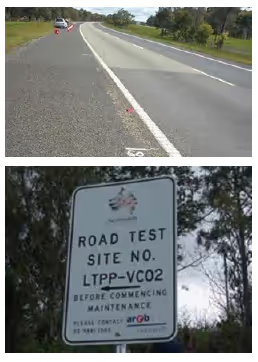
Apart from the observational data collected at these sites, the study included an experimental data collection using the accelerated loading facility (ALF) from 1999 to 2001 conducted on test pavements under controlled environmental conditions at Dandenong, Victoria (see Figure 2). The ALF experiments were aimed specifically at quantifying, in terms of roughness and rutting, the impact on pavement deterioration of surface maintenance treatments and increased axle loads (Martin 2010a, 2010b).
The results of these experiments were expressed in terms of the relative roughness and rutting performance factors for maintenance, rpfmiri and rpfmrut, and the relative roughness and rutting performance factors for increased axle load, rfpliri and rfplrut. These relative performance factors were applied to the observed values of roughness and rutting to supplement the observational data to increase the range of its variables for maintenance and axle loading changes. Both the observational and supplementary data were used to derive the road deterioration (RD) models for arterial road roughness and rutting.
Table 1 summarizes the relative performance factor estimates for various surface maintenance treatments and Table 2 summarises the relative performance factors for axle load increases.
Table 1 Summary of estimated relative performance factors for maintenance treatments relative to a double seal. Source Martin 2010a.
Table 2 Summary of estimated relative performance factors changes in axle load. Source Martin 2010b.
The three phases of road deterioration that occur over the passage of time and traffic load are shown in Figure 3. The first phase, initial densification, occurs within the first 12 months after the pavement is opened to traffic. Initial densification is apparent in certain forms of permanent distress such as rutting and roughness. Initial densification may also lead to an increase in pavement strength, but this is not usually accounted for in deterministic RD modelling.
The second phase of road deterioration, gradual deterioration, is the phase where most in-service pavements operate. Figure 3 shows that gradual deterioration proceeds at a low rate and is virtually linear. The third and final phase of deterioration is the rapid deterioration phase which is difficult to predict as the pavement approaches ultimate failure.
Pavement prediction of in-service pavement performance is in the gradual deterioration phase, involving the prediction of both road deterioration (RD) and the impact of works effects (WE) in maintaining acceptable levels of service to the road users, as shown in Figure 4. Both the RD and WE models, when incorporated in a PMS, are vital for use in estimating funding for medium to long term maintenance and enhancement works and predicting road wear costs associated with heavy vehicle use.
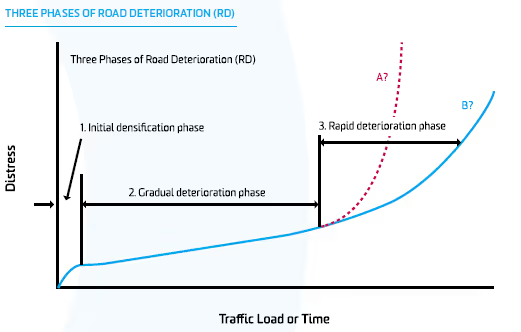
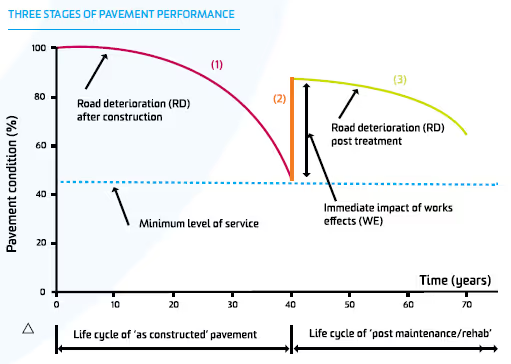
In the development of RD models some initial filtering of the LTPP/LTPPM observational datasets was needed to:
• Eliminate out of range variables and obvious data errors.
• Select deteriorating condition data for roughness, rutting and cracking RD models to ensure data is either stage (1) or stage (3) of deterioration.
The latter filtering is critical to ensure that data under deteriorating conditions are captured and not included with the works effects associated with rehabilitation (Martin et al. 2006). Similarly, for a time series of deflection data it is important to filter out reductions in deflection due to rehabilitation works. However, it has been observed that reductions in deflection can occur due to a warming climate and low rainfall. These observations need to be reviewed for the future refinement of the structural RD modelling.
The LTPP study published a range of road deterioration (RD) and works effects (WE) models from 2007 to 2017 (Austroads 2007, 2010a, 2010b, 2017) as well as many other related subjects such as, RD model calibrations, performance and design comparisons and the effectiveness of surface maintenance treatments (Austroads 2018).
The current RD models are deterministic mechanistic- empirically based for the gradual deterioration phase for flexible pavement arterial roads in Australia. These types of models are based on theoretical postulations about pavement performance, but can be calibrated, using regression analyses, by observational data (Lytton 1987). These models must adhere to known boundary conditions and physical limits. These models can incorporate interactive forms of distress during pavement life, such as the interaction of rutting with cracking, when these interactions are well understood.
If these models are theoretically sound and correctly calibrated, they may be applied beyond the range of data from which they were developed. The current version of the RD models, which are in a cumulative deterioration form (Martin and Choummanivong 2018), were built using cumulative distress observational data as a time series with each cumulative distress model fitted to the data by a multivariate non-linear regression analysis. For example, in Figure 5 the prediction of total rutting, rut(t), at time, t, is expressed by two main components as follows:
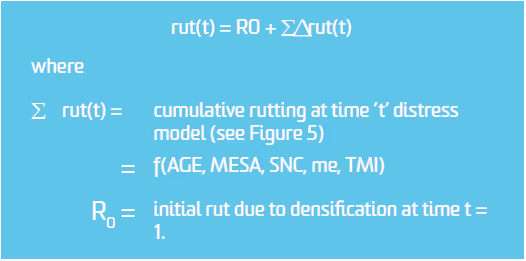
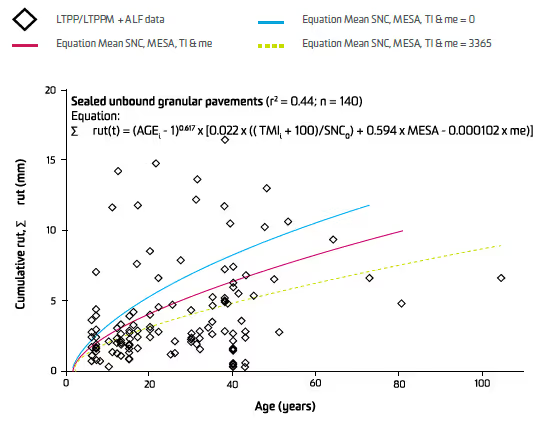
A significant benefit of the current models is that they include parameters that account for changes in heavy vehicle traffic loading, MESA, and climatic conditions, Thornthwaite Moisture Index, TMI (Thornthwaite 1948), as well as the composition and initial strength of the overall pavement/subgrade, SNC0, and maintenance surfacings covering the typical range treatments.
These models have had some refinements since they were published in 2010. The RD models for rutting and cracking have a degree of interaction with the RD model for roughness as shown in Figure 6. However, there is currently no direct interaction of the estimated current pavement/subgrade strength, SNCi, with the RD models for rutting and roughness because it was not supported by the observational data used to develop the models published in 2010.
The current RD models only include statistically significant independent variables, where statistical significance is determined by a Likelihood Ratio (LR) test for non-linear models or a Student ‘t’ test for linear models.
More recently the relative performance factors for surface maintenance treatments, rpfmiri and rpfmrut, were directly used in the rutting and roughness RD models to replace the independent variable for annual maintenance expenditure, me (Martin and Choummanivong 2021).
